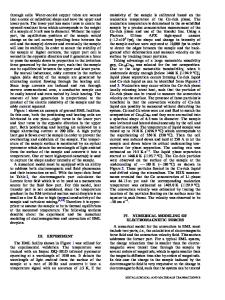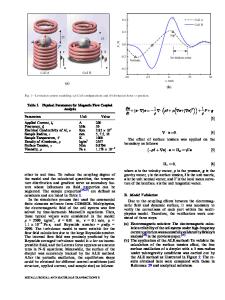Modeling of turbulent flow in electromagnetically levitated metal droplets
- PDF / 2,619,795 Bytes
- 8 Pages / 612 x 792 pts (letter) Page_size
- 54 Downloads / 315 Views
I. INTRODUCTION
ELECTROMAGNETIC levitation (EML) is a widely used containerless processing technique for conductive materials. Its advantages are the avoidance of contamination or chemical reaction at container walls and the ability to perform long-term experiments in a metastable state. It is commonly used to measure thermophysical properties of undercooled liquid metals.[1–5] In the electromagnetic levitation process, a sample weighing approximately 1 g is positioned inside an electromagnetic field generated by alternating currents flowing through an axisymmetric watercooled copper coil. Microgravity conditions are preferable or necessary for some thermophysical property measurements, such as viscosity, which requires measurement of the attenuation of droplet oscillations. Traditionally, mathematical modeling has been done in tandem with both earth- and spacebound electromagnetic levitation experiments in order to determine the effect of the magnetic field on characteristics of the materials, such as power absorption, internal fluid flow, thermophysical properties, solidification rate, and resulting microstructure.[6–11] These calculations are important because they allow the design and planning of experiments and correct interpretation of their results. In addition, the calculations are of fundamental scientific interest, and they can be applied to other electromagnetic materials processing applications, such as electromagnetic stirring and continuous casting.[12] One important piece missing from this overall picture thus far is the lack of detailed knowledge about fluid flow inside the droplets.[12,13] In particular, it is not known S. BERRY, formerly Graduate Student with the Department of Mechanical Engineering, Tufts University, is Associate Staff Member, MIT Lincoln Laboratory, Lexington, MA 02420. R.W. HYERS, formerly Graduate Student with the Department of Materials Science and Engineering, Massachusetts Institute of Technology, Cambridge, MA 02139, is Research Scientist, NASA, Marshall Space Flight Center, Huntsville, AL 35812. B. ABEDIAN, Associate Professor, and L.M. RACZ, Assistant Professor, are with the Department of Mechanical Engineering, Tufts University, Medford, MA 02155. Manuscript submitted July 20, 1998. METALLURGICAL AND MATERIALS TRANSACTIONS B
when the transition to turbulence occurs, as comparatively little analysis and modeling has been performed on this topic.[12,14] The latest work on levitated droplets that considers turbulence was done by Schwartz et al.[6,12,14] who used a “zeroequation” enhanced-viscosity model to represent turbulent effects. They indicated that this model is by no means exact, but that there is no satisfactory turbulence model that accurately models flow in a system that has both a free surface and exhibits strong recirculating flow. This conclusion was based on earlier results by El-Kaddah and Szekely,[15] who used the k2« turbulence model to obtain an estimate of mT in levitated droplets. Their study correctly shows a reduction of turbulent eddy viscosity near
Data Loading...











